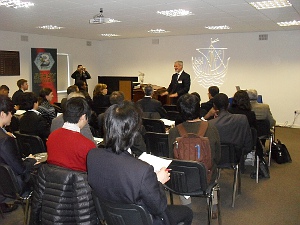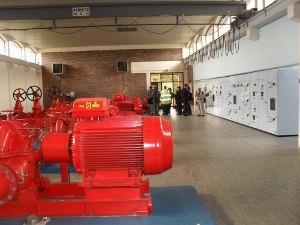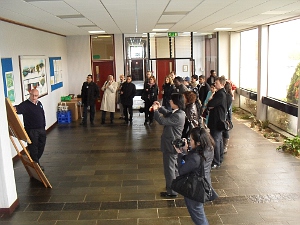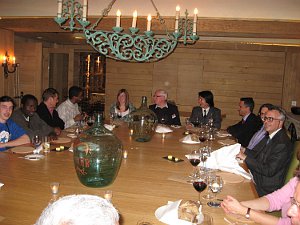1st International Conference on the Design, Construction, Maintenance, Monitoring and Control of Urban Water Systems
25 - 27 April 2012
New Forest, UK
Overview
 The 1st International Conference on the Design, Construction, Maintenance, Monitoring and Control of Urban Water System – Urban Water for short – took place at the Wessex Institute Campus in the New Forest National Park, UK.
The 1st International Conference on the Design, Construction, Maintenance, Monitoring and Control of Urban Water System – Urban Water for short – took place at the Wessex Institute Campus in the New Forest National Park, UK.
The meeting was organised by the Politecnico di Milano, represented by Professor Stefano Mambretti, and the Wessex Institute of Technology, represented by Professor Carlos Brebbia, both Co-Chairmen of the conference. The meeting was sponsored by WIT Transactions on the Built Environment and by the International Journal of Sustainable Development and Planning.
As our cities continue to expand, their urban infrastructures need to be re-evaluated and adapted to new requirements related to the increase in population and the growing areas under urbanisation. The conference considered these problems and dealt with two main topics: water supply systems and urban drainage.
Water distribution networks, as a primary part of water supply systems, represent one of our main infrastructure assets, and therefore effective, efficient and energy saving management is necessary in order to optimize their performance. Moreover, these systems often suffer substantial losses which represent wastage of energy and treatment. Sewer systems are under constant pressure due to growing urbanization and climate changes. The environmental impact caused by urban drainage overflows is related to both water quantity and water quality.
New systems should reduce economic losses and environmental impacts as well as present a higher degree of reliability. Improved management, measurement and control are needed to ensure the efficiency and safety of urban water systems.
Opening Address
 The meeting was opened by Carlos A Brebbia who referred to the importance of the conference programme for the Institute to fulfil its most important function, ie act as a medium for knowledge transfer at an international level. WIT achieves this aim through its Conferences, Seminars and Courses organized throughout the world, usually in conjunction with a well known academic institution, such as in this case the Politecnico di Milano.
The meeting was opened by Carlos A Brebbia who referred to the importance of the conference programme for the Institute to fulfil its most important function, ie act as a medium for knowledge transfer at an international level. WIT achieves this aim through its Conferences, Seminars and Courses organized throughout the world, usually in conjunction with a well known academic institution, such as in this case the Politecnico di Milano.
A by product of the Institute’s activities has been the establishment of WIT Press, now publishing a substantial number of books other than those originating at conferences, in addition to a growing number of scientific journals.
Another important function of Ashurst Lodge is supporting industry through the development of advanced engineering tools. WIT research has originated the Boundary Element Analysis Code (BEASY) which is now well established in major industries such as petroleum, aerospace, and various others in the world of engineering. The success of BEASY validates the research work carried out by the Institute.
Over the years, WIT has developed Ashurst Lodge into a modern campus built in a style in keeping with its surroundings and the heritage of the New Forest, which is an area of outstanding natural beauty. The campus has modern facilities including a new indoor pool and gymnasium and the accommodation is continuously being upgraded. WIT feels that improving the quality of life on campus contributes to the better performance of researchers and staff.
Conference Topics
The papers presented at the Conference made a significant contribution to the solution of Urban Water problems. They were divided into the following topics:
- Water supply
- Water quality
- Water distribution
- Fluid control
- Water and sustainability
Special Session
There was also a special session organised by Professor Goffredo La Loggia of the University of Palermo on ‘The Italian School of Urban Drainage’.
The proceedings were enhanced by a series of Keynote Addresses presented by well known colleagues ie.
- Genetic algorithms for leak detection in water supply networks
S Mambretti, Politecnico di Milano, Italy - Simulated annealing algorithm for water systems optimisation
M Cunha, University of Coimbra, Portugal - Building a new optimization environment based on Particle Swarm Optimization
J Izquierdo, Politechnic University of Valencia, Spain - Impact assessment of industrial effluents on groundwater quality
V Popov, Wessex Institute of Technology, UK - Demand uncertainty in modelling water distribution systems
R Magini, University of Rome, La Sapienza, Italy - The challenges facing Portsmouth Water and water companies in the South East
A Neve, Portsmouth Water Ltd, UK - The role of drainage in urban flood risk management, lessons from case studies collected for the Urban Flood Risk Management Handbook
D Proverbs, University of the West of England, UK - Flood control in small urban rivers: an example of river projects in Tokyo
M Takezawa, Nihon University, Japan - Disaster risk management and urban hydrology: Manila case study
G Moys, Artelia International, France - Performance evaluation of water sector towards low carbon society using business process modelling
N Hirayama, Kyoto University, Japan
Technical Excursion
A technical excursion was arranged during the second afternoon of the meeting to visit the Water Treatment Works on the River Itchen in Southampton.
The Works came into operation in 1973 and a water storage reservoir was added in 1983. Since commissioning, a number of treatment improvements have taken place including a major refurbishment between 1988 and 2001, and in 2007 a membrane filtration plant was also added.
The Manager of the site, Steve Manning, gave a general presentation on the various treatment processes which are used to improve the quality of the water. This was followed by a site tour to look at the individual treatment processes in more detail.
After the tour, the bus left for Winchester where delegates had the opportunity to look around this historic city (once the capital of England) and visit the famous Cathedral, the oldest in England.


Visit to Bucklers Hard
Another interesting social occasion took place over lunch during the first day of the Conference. It consisted of a visit to nearby Buckler’s Hard, which is a picturesque site of great historical interest.
Ships were built here for nearly 100 years and launched directly onto the Beaulieu River. The port was originally intended to be a trading port rather than a shipyard. The idea was to process there the sugar that the Lord of the Manor planned to grow on the West Indies islands of St Lucia and St Vincent, given to him by George I. The war with the French foiled this attempt and it was decided to build ships instead. At its height there were five slipways and around 20 cottages. Only two rows of cottages now remain with a broad village street separating them and sloping towards the river. At the end of one row stands a hotel, which was the master builder’s house and one of the builders’ cottages is now a tiny chapel. An excellent Museum at the entrance of the village describes the activities that took place.

Many fine wooden ships were built there including the famous Agamemnon, commanded by Nelson during the siege of Calvi, in which he lost the vision of his right eye. This ship, together with Swiftsure and Euryalus, all built at Buckler’s Hard, took part in the Battle of Trafalgar. Buckler’s Hard was a major shipbuilding centre, with 53 ships being launched there from 1740 to 1820, which compares favourably with 47 built at Southampton during the same period.
In 1818 the construction of ships ceased, mainly as a consequence of the enterprise having over-extended itself. They had contracted to build four ships simultaneously but were unable to deliver them on time to the navy, and the resulting fines and litigation destroyed the business.
Conference Dinner & Barbecue
 The Conference banquet took place in an outstanding hotel near the WIT campus, within the remains of the original building that had many historical associations.
The Conference banquet took place in an outstanding hotel near the WIT campus, within the remains of the original building that had many historical associations.
The land in which the hotel now stands was called Old Park and in 1319 researched as being the property of the Queen Consort of Edward II, Queen Isabella and in 1331 it became that of Queen Philippa, wife of Edward III.
In more modern times the land was leased by the Crown to different tenants. It was sold to Captain William Morant, famous as the master of the New Forest Hounds, and who made considerable improvements to the property.
After a new change of ownership, the house was leased to Canon Willingham Rawnsley, who set up a school for gentlemen on the premises, called Park Hill. The school is reputed to have had Thomas Stearns (T S) Eliot (1888-1965), the famous poet, as a master. Eliot was born in St Louis, Missouri, and became a British citizen in 1927. He was awarded a Nobel Prize for Literature in 1948.
Another famous teacher was A F Tschiffely, a colourful adventurer of Swiss origin who is closely connected to Argentina, where part of his family lived for several generations. Tschiffely is best remembered for a series of books on his trips in South America, especially the trek he undertook with two Patagonian horses from the Pampas to New York, where he was received as a hero. A result of this trip was a delightful book called Tschiffely’s Ride.
 Park Hill School had to close at the beginning of World War I and amalgamated with the Priory, another preparatory school in Malvern. The closure of the school was followed by the sale of Park Hill, which was eventually turned into a hotel. The beauty of the surroundings, the tranquillity, the friendly service and the excellent cuisine make this one of the most pleasant hotels in our part of the country. The conference dinner consisted of some of the excellent dishes for which the Hotel is internationally renown. Participants at the end of the dinner were offered a piece of pottery specially commissioned for the occasion as a souvenir of their visit to WIT.
Park Hill School had to close at the beginning of World War I and amalgamated with the Priory, another preparatory school in Malvern. The closure of the school was followed by the sale of Park Hill, which was eventually turned into a hotel. The beauty of the surroundings, the tranquillity, the friendly service and the excellent cuisine make this one of the most pleasant hotels in our part of the country. The conference dinner consisted of some of the excellent dishes for which the Hotel is internationally renown. Participants at the end of the dinner were offered a piece of pottery specially commissioned for the occasion as a souvenir of their visit to WIT.
Another social occasion was a lamb barbecue which took place at the WIT Campus. The food was excellent and the event gave an opportunity for the participants to know each other better.
Book Launch
The Conference was also the occasion for the advanced launching of the new book by Stefano Mambretti entitled ‘Fluid Transients in Pipes’. Hydraulic transients in pipes are a phenomenon of paramount importance in the design of networks, as the resulting pressure changes can be dramatic. Unfortunately, their assessment, especially in the case of complex systems and networks, might be a difficult task because of the velocity of the transients and the high oscillations it produces, which sometimes cause numerical instabilities.
The book covers the classical theories, together with the more updated and less known aspects. All theories and mathematical and numerical models presented in the book are checked by means of computer codes, available for readers. Classical theories results are compared against new models and experimental studies.
Devices used to reduce the effects of the transients: such as air chambers, surge tanks, check valves, and others are described, modelled and tested with a computer code which is provided. Pressures arising from transients have not only negative effects, but they can be used for a number of purposes: hydraulic rams, search for water supply networks leakages and others, which are described in the book, with practical examples included.
Advanced effects like cavitation, two-dimensional models, frequency-domain studies, new devices are also presented. The book also presents a number of case studies (laboratory and in field), with different degrees of complexity.
The book is available from WIT Press (ISBN: 978-1-84564-680-6 ) and can be ordered from www.witpress.com site.
Conference Proceedings
The proceedings of Urban Water, 306pp (Print ISBN: 978-1-84564-576-2 ; eISBN: 978-1-84564-577-9) are available from WIT Press. Orders can be placed on the WIT Press web site at www.witpress.com or by email:
Papers from the conference will also be hosted online at the WIT eLibrary as Volume 143 of WIT Transactions on the Built Environment (ISSN: 1746-4498, Digital ISSN 1743-3509). For more details visit the WIT eLibrary at http://library.witpress.com

 Wessex Institute
Wessex Institute